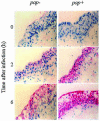Toll-like receptor 4 expression and cytokine responses in the human urinary tract mucosa
- PMID: 15155619
- PMCID: PMC415697
- DOI: 10.1128/IAI.72.6.3179-3186.2004
Toll-like receptor 4 expression and cytokine responses in the human urinary tract mucosa
Abstract
Mucosal pathogens trigger a local innate host response by activating epithelial cells. Bacterial adherence and Toll-like receptor 4 (TLR4) signaling have been implicated as key events in this process. This study addressed the molecular basis of the epithelial response to gram-negative infection in the human urinary tract. Mucosal biopsies were obtained from kidneys, ureters, and bladders of patients undergoing urinary tract surgery, and epithelial TLR4 and CD14 expression was examined by immunohistochemistry. TLR4 was detected in epithelial cells lining the entire urinary tract and in the renal tubular epithelium. CD14, in contrast, was completely absent from the epithelial tissue. The response of the epithelial cells to infection was studied by in vitro challenge of the biopsies with uropathogenic Escherichia coli bacteria. A rapid cytokine response was observed, with production of interleukin-1beta (IL-1beta), IL-6, and IL-8 but not of IL-4 or gamma interferon. Adhering, P- or type 1-fimbriated E. coli activated IL-6 and IL-8 production more efficiently than the nonfimbriated control, as shown by cellular staining and analysis of secreted cytokines. The results demonstrate that human uroepithelial cells possess the molecular machinery needed to respond to uropathogenic E. coli. This includes recognition receptors for fimbriae and TLR4 for transmembrane signaling. We speculate that the lack of membrane-bound CD14 allows the epithelium to regulate its sensitivity to lipopolysaccharide and to discriminate between more-virulent and less-virulent strains.
Figures






References
-
- Backhed, F., L. Meijer, S. Normark, and A. Richter-Dahlfors. 2002. TLR4-dependent recognition of lipopolysaccharide by epithelial cells requires sCD14. Cell Microbiol. 4:493-501. - PubMed
-
- Backhed, F., M. Soderhall, P. Ekman, S. Normark, and A. Richter-Dahlfors. 2001. Induction of innate immune responses by Escherichia coli and purified lipopolysaccharide correlate with organ- and cell-specific expression of Toll-like receptors within the human urinary tract. Cell Microbiol. 3:153-158. - PubMed
-
- Bergsten, G., M. Samuelsson, B. Wullt, I. Leijonhufvud, H. Fischer, and C. Svanborg. PapG dependent adhesion breaks mucosal inertia and triggers the innate host response. J. Infect. Dis., in press. - PubMed
-
- Beutler, B., and E. T. Rietschel. 2003. Innate immune sensing and its roots: the story of endotoxin. Nat. Rev. Immunol. 3:169-176. - PubMed
Publication types
MeSH terms
Substances
LinkOut - more resources
Full Text Sources
Other Literature Sources
Medical
Research Materials

